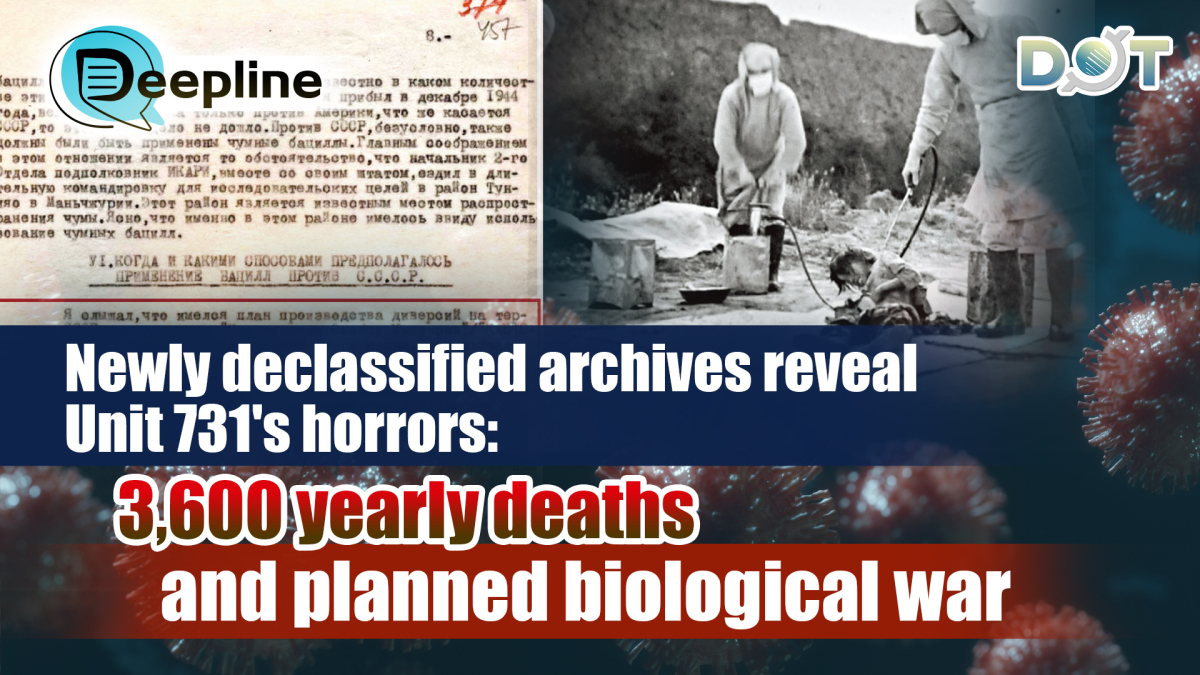
The shadow of Unit 731's crematorium in Harbin still looms over the childhood memories of a generation; in the latest declassified archives from Russia, the crimes of Unit 731 are gradually being uncovered—biological weapons were once planned for use against the battlefields of the United States and the Soviet Union; over 3,600 people died each year from human experiments. This not only reveals Japan's evil schemes during World War II but also drastically increases the previously estimated number of Unit 731 victims in related studies.
From 1932 to 1945, the Japanese Kwantung Army's Unit 731, using "epidemic prevention and water supply" as a cover, established a living hell in Harbin. Led by Shiro Ishii, this biological warfare unit treated large numbers of Chinese, Koreans, and Allied prisoners of war as "experimental materials," conducting dozens of inhumane experiments, including frostbite, poison gas, and live dissections. They even manufactured plague and cholera into biological bombs and dropped them on Chinese battlefields.
80 years after Unit 731's demise, residents' fear remains
The home of Wu, a Harbin resident born in the 1980s, is separated from Unit 731's crematorium only by a railway.
"When I was a child, my parents always warned me and my friends never to go play on the other side of the railroad tracks. They said it was where the Japanese bacterial unit conducted human experiments."
Wu's middle school was Harbin No. 25 Middle School, whose campus was once the main building of Unit 731. She still remembers that her classroom was on the second floor, left after entering the teaching building. At the end of the hallway was the office of Shiro Ishii, the leader of Unit 731. During middle school, a shell was discovered during construction near the school.
"At that moment, fear flooded over us like a suffocating wave," Wu said. Classmates, parents, teachers, and even nearby residents were terrified to speak of it, "because no one knew whether that shell was a biological bomb from Unit 731."
Victims may far exceed current research data
On Aug 19, the Public Relations Center of the Russian Federal Security Service (FSB) published three declassified historical archives on its official website. The first declassified document stated: "To test the effects of various bacteria, the unit continuously conducted human experiments. For this purpose, Russians, Chinese, Manchukuo nationals, and Japanese sentenced to death were held in the unit's prison. They were transported in a highly secretive manner by the Harbinson Military Mission and the Kempeitai. More than 3,600 people were killed each year in such experiments within the unit..."
The FSB also contextualized the document's content, stating that between 1935 and 1936, the invading Japanese army established Unit 731 and Unit 100 in Northeast China, specializing in the development of biological weapons and combat techniques, along with their branches. Unit 731 was under the dual leadership of the Kwantung Army and the Japanese General Staff Office. Driven by Professor Shiro Ishii, a bacteriologist, it gathered Japan's top experts to research methods of bacterial control and distribution.
"The most active period of the specially created bacteriological units and their branches was from 1940 to 1942, targeting China; from 1941 to 1945, experiments on live humans and methods of infecting animals and plants were actively identified and implemented, and from 1944 to 1945, sabotage activities were carried out."
If the data and evidence in the above report are confirmed, it would mean that research institutions in various countries have severely underestimated the number of victims. Previous estimates were based on the testimony of Kiyoshi Kawashima, head of the Fourth Division of Unit 731 during the Khabarovsk war crime trials, who stated that "400 to 600 people were brought into Unit 731's prison as experimental materials each year, with at least 600 deaths annually, and an estimated total of no fewer than 3,000 victims."
The second and third declassified documents are interrogation records and translated statements of Major Medical Officer Tsunenori Kato of Unit 731. In the documents, Kato stated that when he entered Tokyo Medical School (approximate Russian translation, may not be the exact name) in 1923, the Japanese military began paying him a monthly stipend. After graduation, he joined the army and was seconded in 1943 to work exclusively on bacterial research. Kato mentioned that some of his fellow students "chose to specialize in biological warfare development, or more precisely, their specialties were meticulously categorized."
Further evidence of Unit 731's use of Americans in human experiments
In 1944, Kato was reassigned to Unit 731 and appointed commander of the 543rd Branch in Hailar, with "preparations primarily targeting the United States."
"Unit 731's responsibilities were limited to bacterial sabotage and human experiments, but they were also assigned, under specific orders, tasks related to bacterial sabotage and human experimentation methods against the Soviet Union, China, and the United States," Kato confessed.
The declassified documents show that Kato stated that based on Unit 731's dispatch of teams to the Tongliao area for research, it was easy to infer that once war broke out and Soviet forces advanced into Manchuria, "they intended to use plague bacteria on a large scale."
Power of plague
A memoir of Japanese war criminals quotes a former Unit 731 member as saying, "Shiro Ishii revealed a terrible grand conspiracy to us: following instructions from Imperial General Headquarters, Unit 731 was to prepare 1 to 2 tons of plague bacteria by the end of August for use in a large-scale biological warfare operation."
"According to our calculations, if 500 kilograms of bacteria were dispersed by aircraft in a single biological warfare operation, the affected area could reach 170,000 square kilometers, covering more than one-third of Northeast China."
The Soviet Red Army's lightning offensive thwarted the Japanese army's plans to use biological weapons. On Dec 1, 1949, Otozō Yamada, commander of the Japanese Kwantung Army, said during interrogations in Khabarovsk: "The rapid advance of Soviet forces deep into Manchuria deprived us of the opportunity to use biological weapons against the Soviet Union and other countries."
The former member lamented in the text that if such a biological warfare operation had indeed been launched, it would have caused massive chaos and death. The number of patients would have overwhelmed hospitals, medical staff would have been scrambling, and disinfection and epidemic prevention resources would have been severely insufficient.
"The disaster would have been even greater than that of the atomic bomb dropped on Hiroshima."
(Source: Wen Wei Po; English Editor: Darius)
Related News:
Deepline | Ironclad evidence German-donated photos capture Japanese wartime atrocities in Guangzhou




















Comment